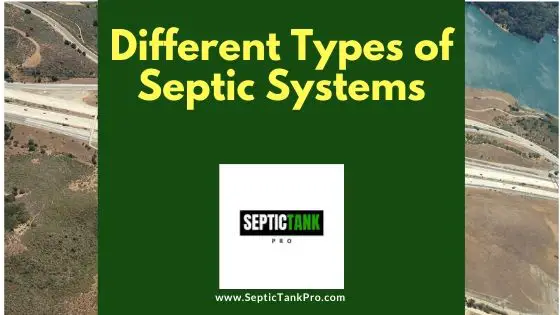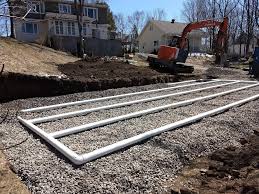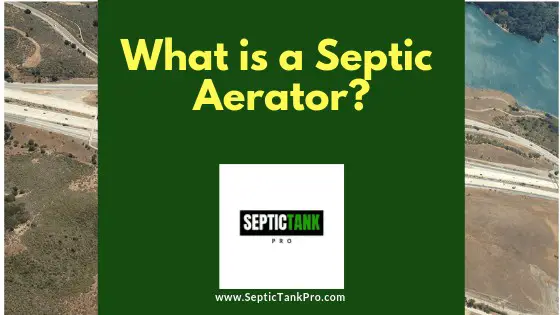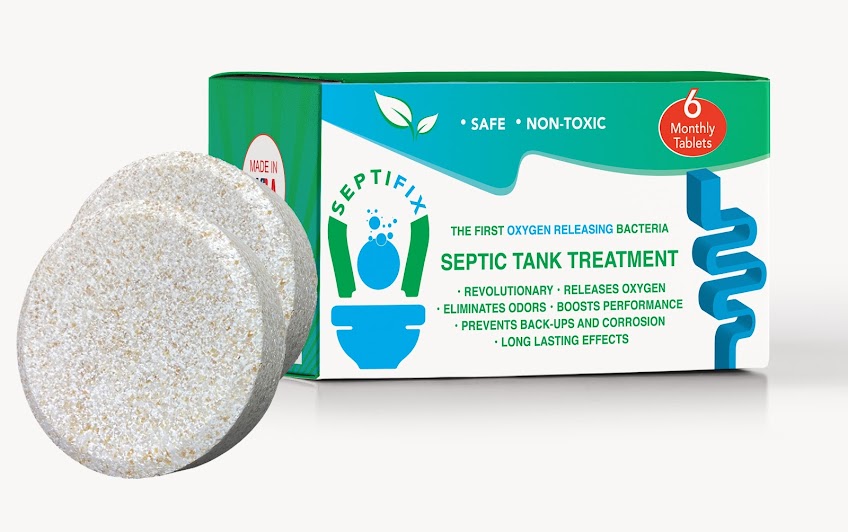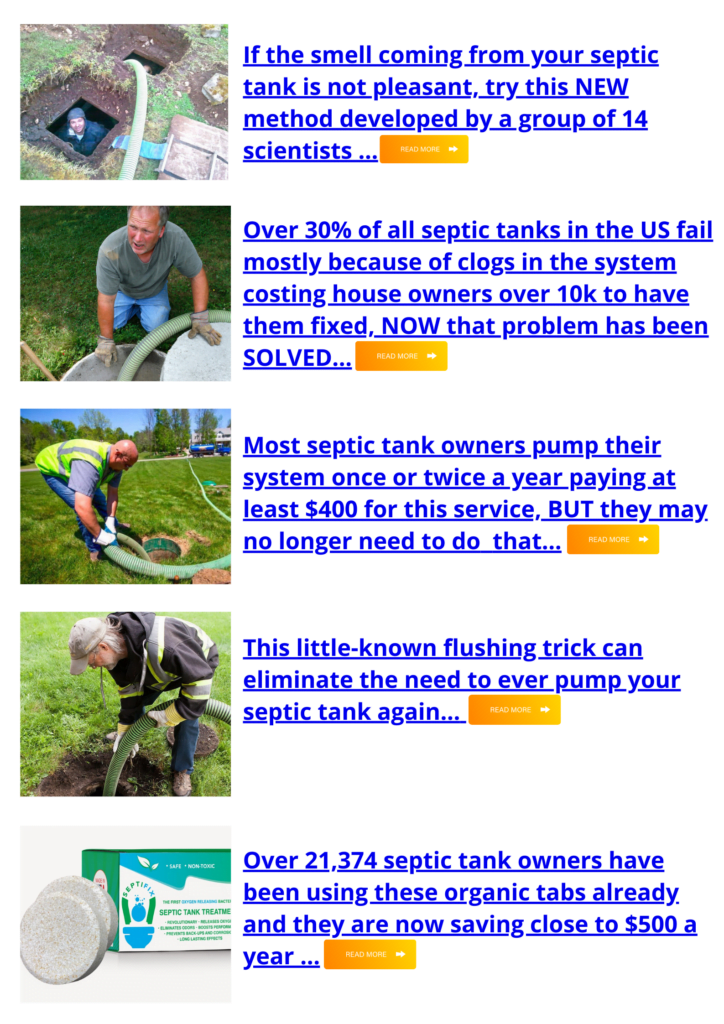How does your septic tank work? — A Guide to How A Septic System Works
What is a Septic System?
Septic systems are dedicated on-site wastewater treatment structures, typically relied on by properties situated in rural areas with no centralized sewer system access available.
These systems use a combination of nature and reliable technology to treat wastewater from the household’s or building’s plumbing coming from its bathrooms, kitchen drains, and laundry. Simple yet effective, these tank-and-soil absorption systems remove solid matter from wastewater and send the treated wastewater into the ground, where filtration, helpful microbial activity, and time all work together to render clean water safe for release to the environment.
Call Septic Service Pros 1.855-925-0760 For Service or Request a Quote
How Does a Septic System Work?
In a nutshell, a conventional septic system consists of a septic tank and a septic drain field (also known as a leach field or soil absorption field). It is in the septic tank where the separation of solid and liquid wastes present in wastewater happens.
The Role of Septic Tanks
Heavier solid waste settles to the bottom of the tank as sludge and the lighter waste (like grease, fat, etc.) floats to the top to form the scum layer.
It is also in the tank where the primary digestion of organic matter is affected. The relatively clearer middle layer, referred to as effluent, is then discharged from the septic tank into a series of perforated pipes buried in the connected drain field, chambers, or other special units designed to slowly release the treated effluent into the soil.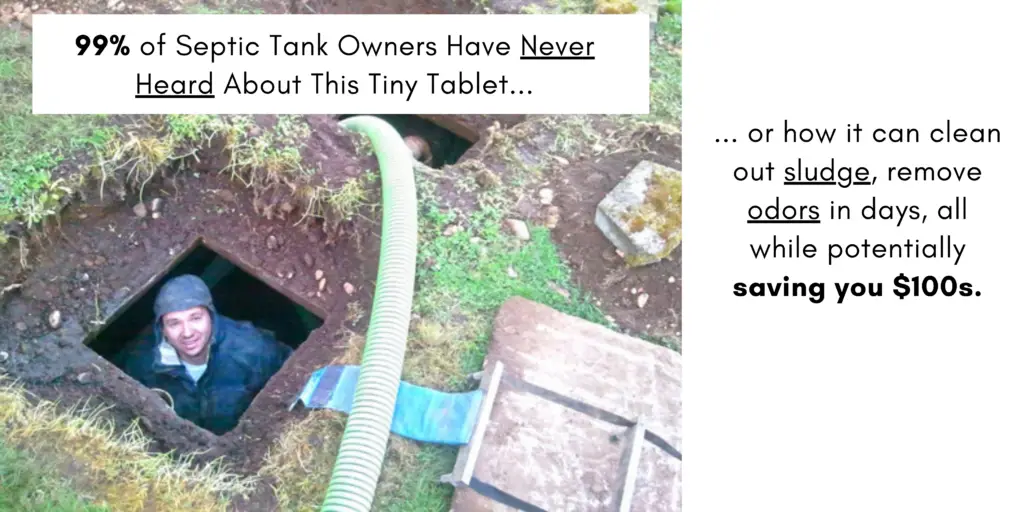
All wastewater runs out of your house or facility through one main drainage pipe connected to your septic tank.
Call Septic Service Pros 1.855-925-0760 For Service or Request a Quote
How Your House Flows into your Septic System – Understand the parts of a septic system
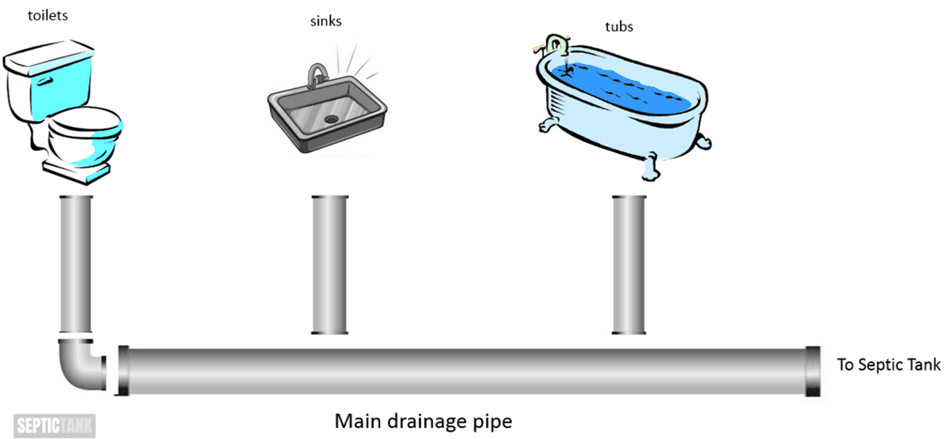
Illustration 1. Sewer Pipe
The septic tank is a water-tight container usually made of concrete, fiberglass, or polyethylene typically buried underground. Its function is to store the wastewater long enough to allow solid wastes to settle down to the base of the tank (sludge layer) and lighter wastes, like oil and grease, float to the top (scum layer).
A T-shaped outlet prevents the sludge and scum from exiting the tank and traveling into the drain field.
Illustration 2: Wastewater Inlet Flow into Septic Tank
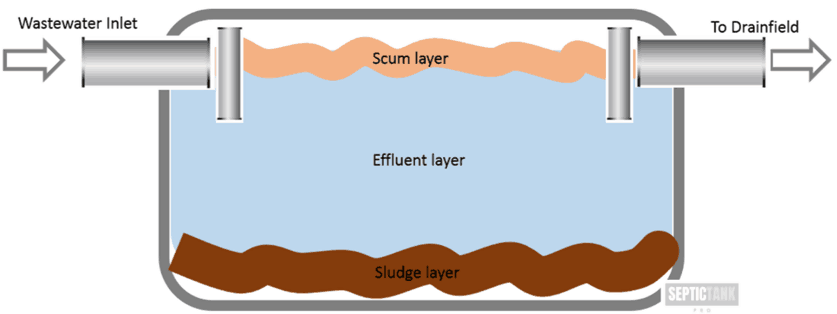 how septic system
how septic system
how it works – diagram 1
Illustration. Inside the Septic Tank
The middle liquid layer (effluent) then exits the tank and into the drain field.
The drain-field is a shallow (covered) excavation ideally in unsaturated soil. The pretreated effluent is discharged through a series of perforated pipes onto porous surfaces that allow the effluent to filter through the soil. The soil receives, treats, and disperses this further-treated wastewater as it percolates through it, naturally removing harmful bacteria, viruses, and other pathogens, before finally discharging to groundwater.
Below is an overview of a simple drain field:
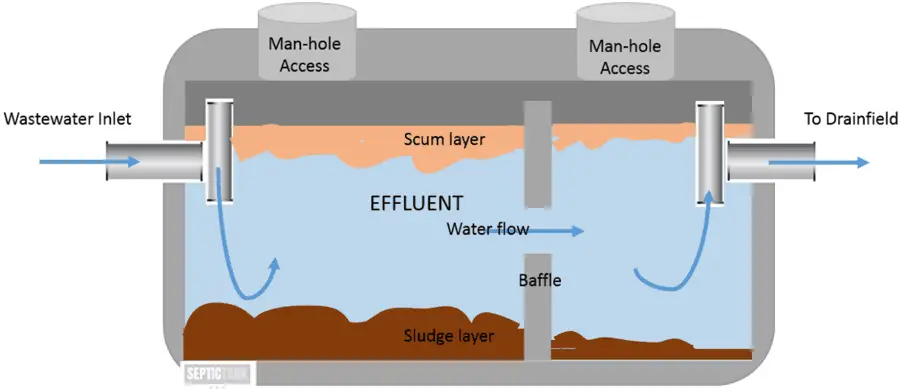 depiction of the inside of a septic tank
depiction of the inside of a septic tank
If a drainfield is overloaded with excessive liquid (from rainwater or surface run-off), it can flood, causing sewage to flow to your ground’s surface and/or sewage back-ups in your toilets, sinks, or drains.
Putting it all together, below is a simple diagram of a typical domestic septic system:
Illustration 3. Drainfield
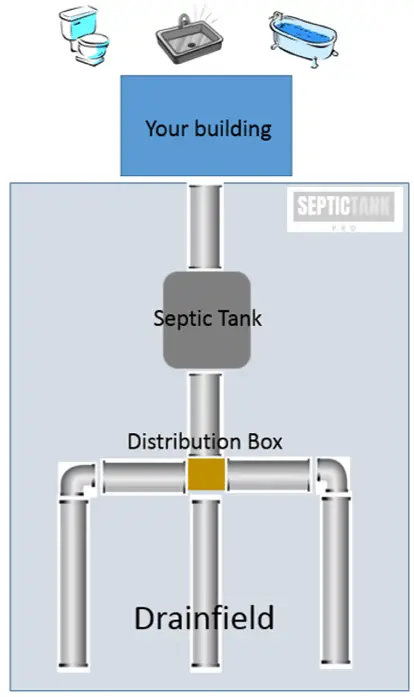 common septic system design image
common septic system design image
Illustration 4. Overview of a Typical Septic System
Call Septic Service Pros 1.855-925-0760 For Service or Request a Quote
The Septic Tank: A Closer Look
Made of concrete, plastic, fiberglass, or steel, septic tanks are the first and most important component in a septic system’s treatment process. It is fitted with two main pipes (as inlet and outlet). The inlet pipe is basically the tank’s connection to the house or building it serves. Wastewater comes into the septic tank through the main sewer pipe from the home or facility, as shown in Illustration 1.
To reiterate, water and waste from every toilet and drain in your home or building make their way into your septic tank, where it remains long enough for a crucial process to be completed. The collected wastewater inside the septic tank needs to undergo the separation of solid and liquid wastes.
There are three (3) resulting layers: the top layer is composed of oil, fat, and grease that float above all the waste. These form the scum layer. The bottom layer is made up of heavier solid matter that sinks down to form the sludge layer. The middle layer that’s left after the settling and floating have happened is a relatively clearer layer of liquid waste with few waste particles remaining. This layer is known as the effluent. Ideally, it is only this middle layer that leaves your septic tank to travel onto your drainfield. Refer back to Illustration 2 for the cross-section of a septic tank.
Illustration 3. Drainfield
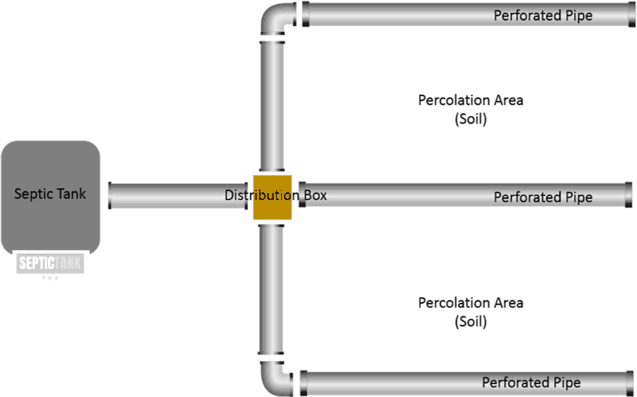 drainfield diagram
drainfield diagram
Inside the tank, helpful bacteria digest the solid waste. These bacteria decompose the solid organic matter rapidly, allowing the liquid parts to separate and drain away more efficiently.
Most modern septic tanks utilize multiple chambers and baffles to maximize the wastewater’s holding time inside the tank. This allows more time for the solid waste to separate from the liquid and for the bacteria to digest it. This is important as this limits the amount of solid waste that ends up in the drainfield.
Accumulation of solids in the drainfield can lead to clogs and, eventually, system failure. Incoming waste is directed downward in the tank, minimizing disruption to the rest of the tank’s contents. A wall baffle between chambers helps keep most of the sludge out of the final chamber, the contents of which are first to leave the tank for the drainfield. Below is a simple diagram of a multi-chamber septic tank.
Illustration 5. Multi-chamber septic tank
Call Septic Service Pros 1.855-925-0760 For Service or Request a Quote
How Do you maintain a septic system to ensure it runs correctly?
Septic tanks need to be subjected to regular pumping to empty them of all the sludge and scum that have accumulated. If not, the potential problems this brings are numerous, disgusting, and can be fatal for your entire system. You can also use a product like Septifix if you are trying to reduce clogs and corrosion on your septic system, read our full review here. Using a product like Septifix can also help you decrease the need for pumping.
How often you need to have your tank pumped is unique as there are several variables that contribute to the required frequency. For instance, the general average for septic tank pumping is once every 3 to 5 years.
However, smaller tanks would likely need to be cleaned once every 1 to 2 years, as the smaller size means it will fill up faster. If a septic tank is left without regular pumping, toxins and possibly, anti-bacterial substances may start to form, killing the helpful bacteria needed in the digestion of waste.
Interference in normal bacterial activities in one’s septic tank is one of the causes of system failure as excessive solid waste build-up cause blockages, potentially leading to overflowing in the system. It is always best to have a trusted septic service professional do annual inspections of your septic tank and other system components in order to determine when the next pumping should be and, more importantly, to gauge the overall health of your septic system.
CALL NOW FOR SERVICE: 1 (855) 925-0760
Every responsible property owner would know to follow a strict septic tank maintenance routine to protect the system against clogging and failure. Most septic tanks need to be pumped every 3 to 5 years, on average. The actual frequency will depend on the system’s tank size, the number of solid wastes allowed into it, and the overall usage habits of the users.
The only way to be certain of how frequently a particular septic tank needs to be pumped is to have it submitted to inspection annually. Measuring the sludge and scum layers’ thickness determines when pumping is required. Whenever the bottom of the scum layer is within 3 inches of the bottom of the outlet baffle or if the top of the sludge layer is within 12 inches of the bottom of the outlet fitting, then you know that your septic tank needs to be pumped out.
If you cannot remember when your septic tank was last pumped, this could be your first sign to expect a system problem sooner than you think. Neglecting to have a septic tank pumped over a long time slows down the decomposition process, leading to blockage and sewage overflow. Over time, excrement, food, and other solid wastes build-up, and if left to accumulate, the septic system could give up and back up completely.
It is not always easy to detect when a septic system is in trouble. A septic system’s lifespan can last through several decades or just a year or two. Rather than sitting around and waiting for your septic system to reach its demise, it is simply good sense to act upon the first signs of malfunction. Better yet, having your septic tank regularly cleaned out every 3 to 5 years and having it inspected periodically will certainly optimize your entire system’s life.
Call Septic Service Pros 1.855-925-0760 For Service or Request a Quote
The Leach Field or Drain Field: A Closer Look
As wastewater from your home or building enters your septic tank, it displaces the wastewater that’s already in there. The “older” wastewater flows out of the septic tank and into your drainfield – a septic system’s second major component. The drainfield or leach field is made up of a series of gravel-filled trenches and perforated pipes buried underground.
A typical drainfield pipe is about 4 inches in diameter and is buried in a trench that is typically 4 to 6 feet in depth and a width of 2. Gravel fills the bottom 2 to 3 feet of a trench while dirt covers the layer of gravel. Once displaced by fresh waste, the effluent from the tank makes its way into these perforated pipes, either by gravity or with the aid of a mechanical pump. Distribution boxes can help distribute the effluent about the drainfield. In the ground of the drainfield, the bacterial population is crucial, just as it is in your septic tank.
As the pre-treated effluent trickles out of the perforated pipes, through the gravel, and into the soil, beneficial bacteria (and some other organisms) in the ground digest the pathogens present, leaving clean water to trickle further down and into groundwater reservoirs.
You may have heard the expression, “grass is always greener over the septic tank.” Actually, this is more accurate for the drainfield where the grass really is greener due to the presence of moisture and nutrients in the area. In a healthy and properly-functioning septic system, all the bacteria that are required to process waste is naturally present.
Bacteria that aid our own physiological digestion travel with waste into the septic tank, where they feed and thrive. With each flush of solid waste, new colonies are added.
The real bottom line is that bacteria are what make septic systems work. Beneficial bacteria break down waste, removing harmful pathogens in the process, leaving the water clean enough to safely filter down to the ground. These helpful bacteria are present in the septic tank but do most of the “hard labor” in the drainfield.
A septic system is typically powered by gravity. Wastewater flows down from the facility to the septic tank and then down to the drainfield. This is what’s referred to a completely passive system. The size of a drainfield is determined by the soil conditions in your property, i.e. how well the ground absorbs water. In locations where the ground consists of hard clay that absorbs water very slowly, you will need a much bigger drainfield.
Call Septic Service Pros 1.855-925-0760 For Service or Request a Quote
Types of Septic Systems
Septic system size and design can vary widely across properties due to a combination of factors. These factors include the size of the household, lot size, soil conditions, site slope, proximity to water formations, weather conditions, and even local regulations. Below are just some of the most common types of septic systems utilized across the country.
Conventional System.
Conventional Septic Systems are, basically, individually-serving, on-site wastewater treatment units opted by properties that are not connected to centralized municipal sewer systems. Conventional systems consist of a septic tank and a trench or bed sub-surface wastewater infiltration system: the drainfield (or leach field).
These systems are typically installed in properties with a single-family home or small business facility. In this system, a watertight tank buried beneath the ground receives and partially treats raw wastewater. Heavy solids settle to the bottom of the tank while greases and lighter solids float to the top. The solids stay in the tank while the wastewater is discharged to the drainfield for further treatment and dispersal.
In a gravel/stone-design drainfield, effluent is piped from the septic tank to a shallow underground trench of stone or gravel. A geo-fabric (or similar) material is placed above the trench so sand, dirt, and other contaminants do not enter the clean stone. The effluent percolates through the stone, undergoing further treatment by microbes before it reaches the soil beneath the gravel/stone trench. Gravel/stone-design drain fields are relatively larger and thus may not be suitable for all residential sites or conditions.
Call Septic Service Pros 1.855-925-0760 For Service or Request a Quote
Chamber System.
Gravel-less drain fields have been widely used for over 30 years in many states, becoming a conventional septic system technology replacing gravel systems. These systems can be manufactured with recycled materials and offer a significant reduction in one’s carbon footprint. An example of a gravel-less system is the chamber system.
A chamber system serves as an alternative design to the conventional gravel/stone system. The primary advantage of a chamber system is its ease of delivery and construction. These systems are likewise ideal for areas with high groundwater tables, where the volume of wastewater that enters the septic system is highly variable (such as vacation homes or seasonal lodges), where gravel is scarce, or in areas where other technologies such as plastic chambers are available.
A chamber system consists of a series of connected chambers with the areas around and above these chambers are filled with soil. Wastewater travels from the septic tank to these chambers where the wastewater comes into contact with the soil. Microbes on or near the soil treat this received effluent.
Drip Distribution System.
The drip distribution system is a type of effluent dispersal system that is compatible to many drainfield types. The main advantage of this type of system is that it does not require a large mound of soil because the drip laterals are inserted into the top 6 to 12 inches of soil.
The disadvantage of the drip distribution system, though, is that it requires a large dose tank after the septic tank in order to accommodate the timed dose delivery of wastewater to the drip absorption area. Other additional components, such as electrical power, are necessary to operate a drip distribution system, thus tallying up to added expense and additional maintenance requirements.
Aerobic Treatment Unit.
Aerobic Treatment Units (or ATUs) use many of the same processes as a centralized municipal sewer system but on a smaller scale. An aerobic system pumps oxygen into the treatment tank, increasing the natural bacterial activity within the system that is crucial for the treatment of the nutrients in the effluent.
It is common for aerobic systems to have multiple tanks (such as a pre-treatment tank and a final treatment tank) where further disinfection occurs, reducing pathogen levels in the effluent. The advantages of ATUs include suitability to homes or properties with smaller lots, inadequate soil conditions, and to areas with very high water tables and those that are close to a surface water body that could be sensitive to contamination with nutrients from wastewater effluent. ATUs require regular lifetime maintenance.
Mound Systems.
In areas with shallow soil depths, high groundwater, or thin bedrocks, a mound system is an option. In this system, a constructed sand mound encloses a drainfield trench. Effluent from the septic tank flows to a pump chamber where it is pumped to the mound in measured doses. The treatment of the effluent occurs as it is discharged to the trench and filters through the sand, before it disperses into the soil. While mound systems can be a viable alternative for particular soil conditions, these systems require a substantial amount of space and periodic maintenance.
Recirculating Sand Filter Systems.
In this system, effluent flows from the septic tank to a pump chamber. It is then pumped to the sand filter. The sand filter is typically a PVC-lined or a concrete box filled with sand. Effluent is pumped under low pressures through the pipes at the top of the filtering system.
Treatment happens as effluent leaves the pipes as it filters through the sand. Afterwards, the treated wastewater is discharged to the drainfield. Sand filter systems can either be constructed above or below the ground. Sand filter systems provide a high level of treatment for nutrients and are ideal for locations with high water tables or those that are close to water formations, though these systems are commonly more expensive than a conventional septic system.
Evapo-transpiration Systems.
Evapotranspiration systems require unique drainfields. The bottom of an evapo-transpiration system drainfield is lined with a water-tight material. After the effluent arrives at the drainfield, it evaporates into the air. Unlike with other septic system designs, the effluent never filters to the soil and never reaches groundwater in evapo-transpiration systems.
Although, note that evapo-transpiration systems are only useful in particular environmental conditions. Evapo-transpiration systems require arid climates with adequate heat and sunlight. These systems are optimal in shallow soil. This, however, makes these systems susceptible to failure in the event of heavy rains or snow.
Constructed Wetland System.
A constructed wetland system simulates the treatment processes that occur in natural wetlands, hence the name. Effluent flows from the septic tank and enters a wetland cell. The effluent then passes through the filtration media and is treated by microbes, plants, and other matter that remove pathogens and nutrients.
The wetland cell typically includes an impermeable liner, gravel and sand fill, along with the applicable wetland plants, which must be able to survive in perpetually-saturated environments. A constructed wetland system can work with either gravity flow or with pressure distribution. As effluent flows through the wetland, it may exit the wetland and flow into a drainfield for further wastewater treatment through the soil.
Cluster or Community Systems.
These are decentralized wastewater treatment systems under some form of common ownership. A cluster or community system collects wastewater from two or more facilities and conveys it to a treatment and dispersal system situated near the facilities it serves. In other words, it is similar to a centralized municipal sewer system, but in a much smaller scale. These systems are common in rural subdivisions or similar remote areas.
In summary, the latter alternative septic systems work with the aid of pumps or gravity to allow effluent coming from septic tanks to trickle through sand, organic matter (such as peat and sawdust), constructed wetlands, or other media to remove or neutralize pollutants like disease-causing pathogens, nitrogen, phosphorus, and other contaminants. Some alternative septic systems are designed to allow the evaporation of wastewater or some form or disinfection treatment it before it is discharged to the soil.
Call Septic Service Pros 1.855-925-0760 For Service or Request a Quote
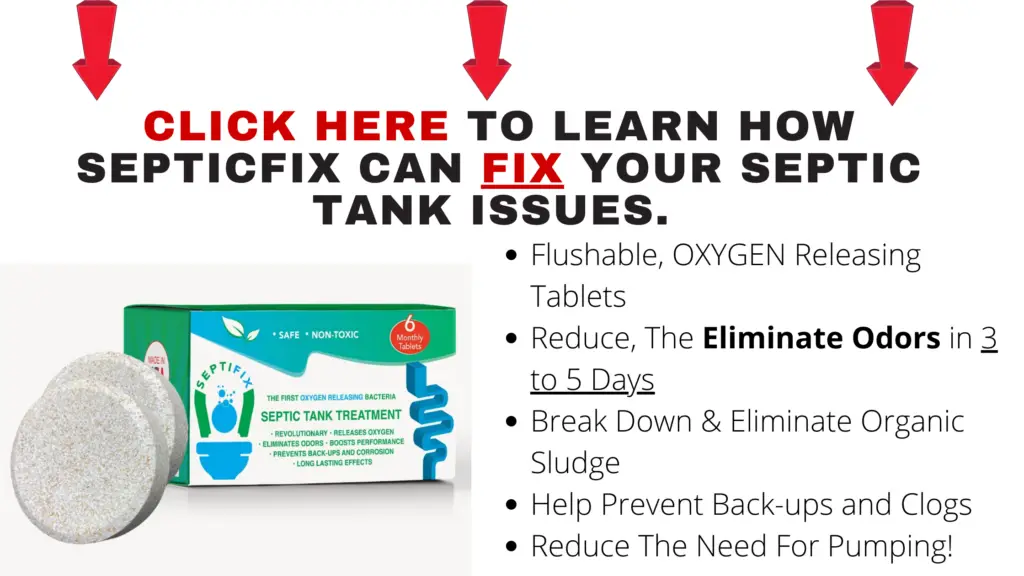
Septic System Maintenance – It’s easy to keep your septic system running smoothly
When a septic system is operating smoothly, it could be easy to neglect it. But every responsible property owner living with a septic system knows that it requires stringent monitoring and maintenance on regular intervals. Aside from having a trusted septic service provider on contract to handle the “dirty work”, a property owner’s primary responsibilities are to enforce the maintenance schedules and to be aware of and observe proper usage practices that can help preserve its functionality and extend the system’s lifespan.
One of the first things to ingrain into every property occupant’s usage habits is to remember that “the toilet is not the trash”. Water, human waste, and toilet paper (biodegradable and septic-friendly, please) are the only things that should be flushed down every toilet. Anything else, and you run the risk of clogged drains, sewage back-ups, a damaged septic tank, and worst of all, a failing drainfield.
Because septic systems treat wastewater on-site (rather than transporting it to full-scale, specialized facilities), conservative water usage becomes crucial. Always remember that the septic tank can only hold so much and, similarly, your drainfield is static (size-wise).
Excessive water consumption may overfill the septic tank, diminishing the time allowed for sewage to separate the solid wastes before it leaves for the drainfield. This can then result to high amounts of solid waste entering the drainfield, leading to clogs and, soon enough, failure. To cut down on water consumption, install as many water-efficient or low-flow fixtures as possible, and space out laundry and dishwasher loads over a few days. Most importantly, find and fix every leak in your plumbing.
Relatedly, make sure that discharges from pools or hot tubs and rain gutter downspouts are diverted away from both the septic tank and the drainfield to prevent flooding in both components.
Septic systems are generally robust and resilient, but only to a certain point. Careless usage that leads to a constant influx of hair, food scraps, FOG (fats, oils, and grease) and harsh chemicals potentially leads to damage and system failure. The basic rule of thumb to adhere to should be easy enough to remember: nothing non-biodegradable should ever find their way into your septic tank.
Install strainers, screens, or filters over your drains. Lint and grease traps, too, for your dish and laundry washers and dryers. These simple, inexpensive things are most useful in keeping coffee grounds, food scraps hair, FOG, and lint out of the tank. A build-up of non-biodegradable and synthetic substances in your septic tank can present problems for the entire system, leading to clogs and potential system failure.
Septic system trouble becomes a real possibility when excessive amounts of non-biodegradable matter and synthetic chemicals are allowed into your system. Whatever you pour or let down any drain affects the health and longevity of your system. Synthetic and harsh chemicals can actually eat away at the good bacteria in your drains and in the rest of your septic tank system.
The absence of this helpful bacteria (that digest and break down waste matter) in your septic system will likely cause clogs, sewage back-ups, foul odor, and a number of other expensive septic problems. Make it a point to use only septic-safe products (always check the label). Remember that biodegradable or environmentally-friendly products are likewise perfectly safe for use if what you have is an on-site dedicated septic system.
Septic system-considerate usage habits and regular pumping of the septic tank go a long way to prevent a clogged drainfield that’s likely on its way to failure. Though most solid waste is processed in the septic tank, it is realistic to expect that small quantities do make it to the drainfield. But the helpful bacteria and other organisms in the ground can usually digest those that make it through.
The problem lies when a septic tank has not been pumped and sludge has accumulated beyond its threshold that all incoming wastewater is pushed out of the tank faster than it needs. The premature release of effluent from the septic tank likely means that it was not given sufficient time for the sludge and scum to separate, settle or float, thus getting carried away to the drainfield.
The distribution pipes and even the absorption soil can become clogged, preventing wastewater from percolating thoroughly enough. Foul odor, sewage puddles, and particularly lush vegetation over the drainfield are all indications of an impending failure. Additionally, you may observe slow drains or toilets and gurgling sounds from the plumbing that cannot be remedied with a plunger or snake as other symptoms of drainfield problems.
Besides making sure the tank gets pumped and careful usage habits, there are a couple of things to avoid or watch out for outside the facility and around the tank and field areas. First would be to ascertain that trees and large shrubs are planted with enough clearance from said areas. Tree roots will naturally be drawn towards the high nutrient levels of the drainfield and the vicinity of the septic tank (especially if there are small leaks present).
These roots can encroach on pipes and even the tank body, causing or aggravating leaks. Trees need to be 30 feet away, at least. Also, avoid driving vehicles or operating heavy machinery over your drainfield (to avoid compacting the soil) and over your septic tank (to avoid the possibility of cave-ins). Likewise, heavy foot traffic (human or otherwise) should be avoided, as well as building heavy structures over said areas.
To summarize, your septic tank is like your settling pond: heavy sold wastes settle down to the base of the tank (forming the sludge layer) while the lighter solids float up to form the scum layer. A relatively clearer middle layer of liquid waste (known as the effluent) is left, awaiting discharge to the drainfield.
Call Septic Service Pros 1.855-925-0760 For Service or Request a Quote
Install an effluent filter in your septic tank system
A septic filter is ideally installed to further prevent solid waste from leaving the tank and entering the outlet pipe. The effluent’s next destination, the septic drainfield, is home to bacteria and microorganisms that are instrumental in the decomposition of pathogens in the effluent before it percolates into the ground. The perforations in the septic pipes in the drainfield allow for the gradual trickling of effluent into surrounding gravel. Gravel allows water to flow into the soil and for oxygen to reach the bacterial colonies. This process cleans up the wastewater, rendering it clean enough to assimilate into the groundwater and aquifer.
Septic systems go by a few different names: on-site wastewater treatment systems, dedicated sewage systems, etc. However they are called, they are essentially crucial wastewater disposal solutions especially for those in remote, rural areas and other locations where centralized sewer systems are not readily available. Because they are on-site, there is, expectedly, a greater degree of responsibility on the hands of the property owners to monitor, maintain, and take good care of them.
Sources Used
https://www.epa.gov/septic/how-your-septic-system-works
https://medium.com/waste-disposal-hub/how-septic-tanks-work-and-when-to-empty-them-346a4fe4fe6f
https://home.howstuffworks.com/home-improvement/plumbing/sewer2.htm
https://www.familyhandyman.com/plumbing/how-a-septic-tank-works/
https://www.plumbingsupply.com/how-a-septic-system-works.html
https://www.pinterest.ph/pin/784963410024689851/
https://en.wikipedia.org/wiki/Septic_tank
https://www.epa.gov/septic/types-septic-systems
https://blog.lyttleco.com/did-you-know..-you-must-have-contract-for-onsite-system


